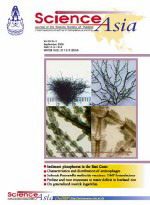ThaiScience
ThaiScience
SCIENCE ASIA
Volume 47, No. 01, Month FEBRUARY, Year 2021, Pages 78 - 85
Vegetation structure of wetlands in eastern himalayan highlands of gasa, bhutan
Pema Tendara, Kitichate Sridith
Abstract Download PDF
The study was conducted on the unexplored wetland vegetation of the eastern Himalayan highlands of Gasa District, Northern Bhutan. A random quadrat sampling of 1 × 1 m2 method was used to assess the presence-absence of species, including shrubs, trees, mosses, ferns, and climbers, that were occurring adjacent to plots. Altogether, 201 taxa from 81 families, distributed in 149 genera, were recorded. Among the total species, 6 bryophytes, 20 monilophytes, 2 gymnosperms, and 173 angiosperms species were found. The most abundant life forms represented were herbaceous (62%) and shrub (29%), followed by tree (7%) and climber (2%). The four unique vegetation structure (represented in schematic profile diagrams) of habitats: fresh water meadow, seasonally flooded basin of flat, shallow fresh marsh, and poor fen, were found. The study suggests protecting ecotone (a transition zone between the wetland and surrounding uplands) as part of the measures to protect wetlands and their vegetation in the Himalayas.
Keywords
wetland, vegetation structure, schematic profile diagram, ecotoneSCIENCE ASIA
Published by : The Science Society of Thailand
Contributions welcome at : http://www.scienceasia.org/
